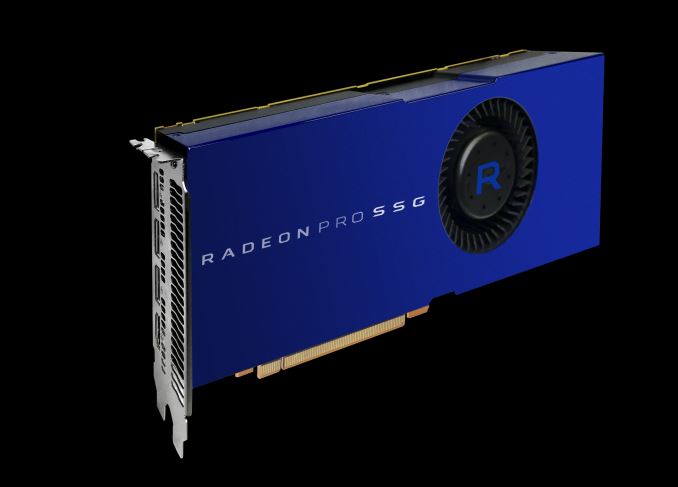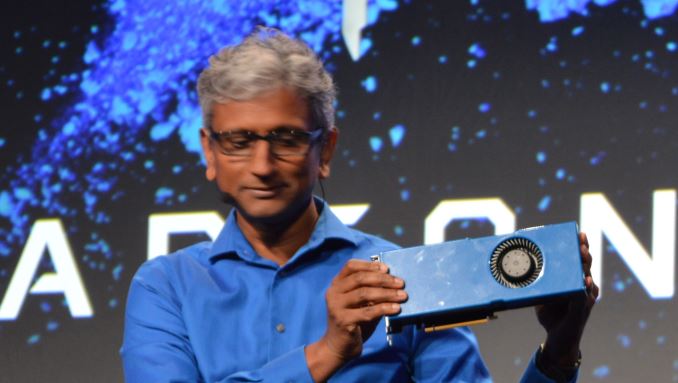Updated: AMD Announces Radeon Pro SSG: Fiji With M.2 SSDs On-Board
by Ryan Smith on July 25, 2016 10:30 PM EST- Posted in
- GPUs
- SSDs
- AMD
- Radeon
- Radeon Technologies Group
- Radeon Pro

As part of this evening’s AMD Capsaicin event (more on that later), AMD’s Chief Architect and SVP of the Radeon Technologies Group has announced a new Radeon Pro card unlike anything else. Dubbed the Radeon Pro Solid State Graphics (SSG), this card includes M.2 slots for adding NAND SSDs, with the goal of vastly increasing the amount of local storage available to the video card.
Details are a bit thin and I’ll update this later this evening, but in short the card utilizes a Polaris 10 Fiji GPU and includes 2 PCIe 3.0 M.2 slots for adding flash drives to the card. These slots are then attached to the GPU (it’s unclear if there’s a PCIe switch involved or if it’s wired directly), which the GPU can then use as an additional tier of storage. I’m told that the card can fit at least 1TB of NAND – likely limited by M.2 MLC SSD capacities – which massively increases the amount of local storage available on the card.
As AMD explains it, the purpose of going this route is to offer another solution to the workset size limitations of current professional graphics cards. Even AMD’s largest card currently tops out at 32GB, and while this is a fair amount, there are workloads that can use more. This is particular the case for workloads with massive datasets (oil & gas), or as AMD demonstrated, scrubbing through an 8K video file.
Current cards can spill over to system memory, and while the PCIe bus is fast, it’s still much slower than local memory, plus it is subject to the latency of the relatively long trip and waiting on the CPU to address requests. Local NAND storage, by comparison, offers much faster round trips, though on paper the bandwidth isn’t as good, so I’m curious to see just how it compares to the real world datasets that spill over to system memory. Meanwhile actual memory management/usage/tiering is handled by a combination of the drivers and developer software, so developers will need to code specifically for it as things stand.
For the moment, AMD is treating the Radeon Pro SSG as a beta product, and will be selling developer kits for it directly., with full availability set for 2017. For now developers need to apply for a kit from AMD, and I’m told the first kits are available immediately. Interested developers will need to have saved up their pennies though: a dev kit will set you back $9,999.
Update:
Now that AMD’s presentation is over, we have a bit more information on the Radeon Pro SSG and how it works.
In terms of hardware, the Fiji based card is outfit with a PCIe bridge chip – the same PEX8747 bridge chip used on the Radeon Pro Duo, I’m told – with the bridge connecting the two PCIe x4 M.2 slots to the GPU, and allowing both cards to share the PCIe system connection. Architecturally the prototype card is essentially a PCIe SSD adapter and a video card on a single board, with no special connectivity in use beyond what the PCIe bridge chip provides.
The SSDs themselves are a pair of 512GB Samsung 950 Pros, which are about the fastest thing available on the market today. These SSDs are operating in RAID-0 (striped) mode to provide the maximum amount of bandwidth. Meanwhile it turns out that due to how the card is configured, the OS actually sees the SSD RAID-0 array as well, at least for the prototype design.
To use the SSDs, applications need to be programmed using AMD’s APIs to recognize the existence of the local storage and that it is “special,” being on the same board as the GPU itself. Ultimately the trick for application developers is directly streaming resources from the SSDs treating it as a level of cache between the DRAM and system storage. The use of NAND in this manner does not fit into the traditional memory hierarchy very well, as while the SSDs are fast, on paper accessing system memory is faster still. But it should be faster than accessing system storage, even if it’s PCIe SSD storage elsewhere on the system. Similarly, don’t expect to see frame buffers spilling over to NAND any time soon. This is about getting large, mostly static resources closer to the GPU for more efficient resource streaming.
To showcase the potential benefits of this solution, AMD had an 8K video scrubbing demonstration going, comparing performance between using a source file on the SSG’s local SSDs, and using a source file on the system SSD (also a 950 Pro).
See what the Radeon™ Pro SSG can do to help drastically improve professional workload enablement #AMDCapsaicinhttps://t.co/ZkcfffSScN
— Radeon Pro (@RadeonPro) July 26, 2016
The performance differential was actually more than I expected; reading a file from the SSG SSD array was over 4GB/sec, while reading that same file from the system SSD was only averaging under 900MB/sec, which is lower than what we know 950 Pro can do in sequential reads. After putting some thought into it, I think AMD has hit upon the fact that most M.2 slots on motherboards are routed through the system chipset rather than being directly attached to the CPU. This not only adds another hop of latency, but it means crossing the relatively narrow DMI 3.0 (~PCIe 3.0 x4) link that is shared with everything else attached to the chipset.
Though by and large this is all at the proof of concept stage. The prototype, though impressive in some ways in its own right, is really just a means to get developers thinking about the idea and writing their applications to be aware of the local storage. And this includes not just what content to put on the SSG's SSDs, but also how to best exploit the non-volatile nature of its storage, and how to avoid unnecessary thrashing of the SSDs and burning valuable program/erase cycles. The SSG serves an interesting niche, albeit a limited one: scenarios where you have a large dataset and you are somewhat sensitive to latency and want to stay off of the PCIe bus, but don't need more than 4-5GB/sec of read bandwidth. So it'll be worth keeping an eye on this to see what developers can do with it.
In any case, while AMD is selling dev kits now, expect some significant changes by the time we see the retail hardware in 2017. Given the timeframe I expect we’ll be looking at much more powerful Vega cards, where the overall GPU performance will be much greater, and the difference in performance between memory/storage tiers is even more pronounced.
Source: AMD












120 Comments
View All Comments
HrD - Tuesday, July 26, 2016 - link
I'm confused about the GPU in use here. Some sites report that according to the information they got from AMD "The Radeon Pro SSG has a single graphics processor based on Fiji architecture, also used in the company's dual-GPU Radeon Pro Duo." while others (such as Anandtech) report that again according to information given by AMD the card uses a Polaris chip. Which one is it?FMinus - Tuesday, July 26, 2016 - link
All those new Radeon PRO cards are based on Polaris.BMNify - Tuesday, July 26, 2016 - link
It's clearly not polarisHollyDOL - Tuesday, July 26, 2016 - link
This is a case where I could imagine a good use of 3D X-Point instead of those SSDs...SentinelBorg - Tuesday, July 26, 2016 - link
This was exactly my thought after reading the first few lines. 3D X-Point would be perfect for this.mjcutri - Tuesday, July 26, 2016 - link
This card isn't about speed, it's about capacity. I used to run FEA in SolidWorks and would run out of memory (vid + sys) all the time on complex models. This would have helped tremendously.Like the article said, it's directed at very specific cases - Oil & gas, FEA within cad, etc. It's not directed at consumers in any way.
vladx - Tuesday, July 26, 2016 - link
Good luck selling $750 worth of hardware for $9999, AMD. Very innovative indeed LOLFMinus - Tuesday, July 26, 2016 - link
They are not selling to you, they are selling to companies which can afford to pay such prices. Do you really think any FirePRO, RadeonPRO, Quadro, Tesla chip is worth what they are asking for, considering most of those products are based on consumer variants which sells for ten times less? No, but the market is different thus the pricing is adjusted.vladx - Tuesday, July 26, 2016 - link
> They are not selling to you, they are selling to companies which can afford to pay such prices.If it was only addressed to big companies and not developers as well, they wouldn't have presented it as a developer kit.
> Do you really think any FirePRO, RadeonPRO, Quadro, Tesla chip is worth what they are asking for...
Yes the price of those cards is worth their price since they cover a lot more use cases while this solution's applications can be counted on one's hand.
xrror - Tuesday, July 26, 2016 - link
I like the theory posted earlier that this card exists because a large customer (like oil & gas, government project, etc.) desired a solution for a specific usage case.What's completely maddening though, is this inadvertently really is a tease for something that AMD has the rather unique product portfolio to have made a truly custom SKU for and didn't.
If you consider AMD's APU experience, and that they would already plan (i assume!) Polaris being designed to be used in their APU architecture + Polaris already is designed as a unified memory and native virtualization support:
I imagine a custom "APU" or SoC that is mainly Polaris + NVe storage controller specifically for this application to be well within AMD's capability.
I really hope they have an opportunity to make a gen 2 of this project, just because it's so different. It also could morph into a sort of "expandable FireGL" or nVidia Tesla competitor?